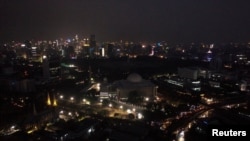Indonesia's massive August 4 power outage is raising new concerns about the state electricity company, and renewing calls to look at alternative power sources, including geothermal energy, solar photovoltaic and wind.
The blackout that hit the state-owned PLN electric company was Indonesia's worst since 2005, affecting millions of people in Jakarta and surrounding areas such as West Java and Banten.
"By diversifying our energy sources by adding renewables, we may have a backup plan reducing the potential of a total blackout," Mamit Setiawan, an analyst with Energy Watch, told VOA.
Setiawan added that the centralized nature of power plants on the country's most populated island of Java increases the likelihood of cascading outages similar to Sunday's incident.
The eight-hour blackout began when lines carrying high voltage failed. The disruption caused other parts of the system to crash, which in turn, caused a domino-like series of further problems affecting power plants in the central and western part of Java, including one that covered the capital.
The blackout hindered many important services, like traffic lights, subways, cell phones and ATMs.
President Joko Widodo, who recently won re-election, visited the PLN office Monday, berating officials for the lack of a backup plan and failure to mitigate the outage.
"In a big management like this, surely there's a contingency plan, a backup plan. My question is, why has none of that worked fast or well?" he asked.
Indonesia's 2009 electricity law gives PLN priority rights over the country's electricity supply. It currently operates over 5,000 power plants, with more in the works as Widoto pledged to enhance the country's electricity-supply infrastructure.
Previously, Widodo expressed distaste for Indonesia's continued reliance on coal and fossil-fired power plants. In February, he cited the wind power plant in the Sidenreng Rappang Regency of South Sulawesi Province as a renewable infrastructure preference.
"With this blackout, I can imagine Joko could prioritize renewables more than...ever," Setiawan said.
In a 2018 report on Indonesia's energy sources, international auditing firm PricewaterhouseCoopers noted that many factors support renewable deployment, "including falling costs, national carbon emissions targets, the high cost of oil-based generation [especially in remote regions] and the regulatory, and physical barriers to gas distribution."
Earlier this year, the Ministry of Energy and Mineral Resources announced that PLN set the target for electricity production at 35,000 megawatts and the target for the contribution of renewables at 23% by 2025.
But renewables remain noncompetitive, according to Setiawan, who says the government is currently deliberating a law that would govern the sector.
Loss and compensation
PLN has apologized for the outage and pledged to conduct an internal investigation.
According to the electricity law, customers can get compensation if negligence caused a blackout.
The director general for electricity at the Ministry of Energy and Mineral Resources, Rida Mulyana, told reporters compensation could amount to "approximately 1 trillion rupiah" ($70.5 million).
PLN previously said it would cut tariffs based on the duration of the blackout. The company reported a 90 billion rupiah ($6.3 million) loss, according to the Indonesian Chamber of Commerce and Industry.
Members of parliament are demanding further explanations for the blackout. PLN faces concerns about alleged inequitable distribution of power. And the company's current acting CEO, Sripeni Inten Cahyani, was appointed after her predecessor was arrested on corruption charges.









